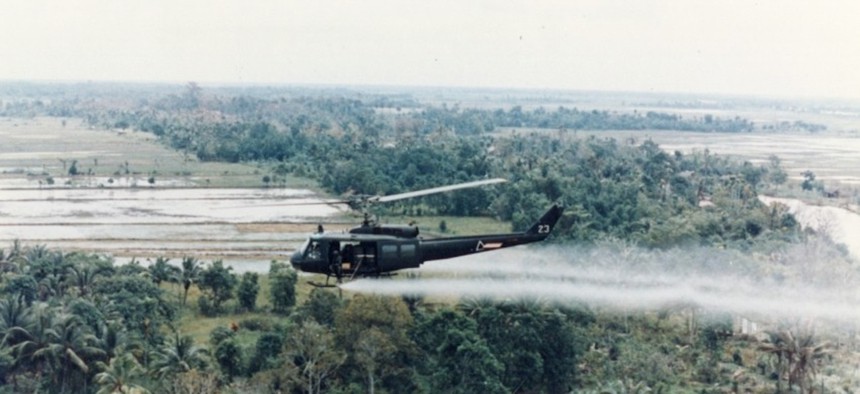The U.S.’s Toxic Agent Orange Legacy
Washington has admitted to the long-lasting effects of dioxin use in Vietnam, but has largely sidestepped the issue in neighboring Cambodia and Laos.
KAMPOUT TUK, Cambodia—Paris Dauk’s left arm lies close to her chest, reminiscent of how a bird bears a broken wing. She’s talkative and has a propensity to fill her face, itself marked by abnormal growths, with a toothy grin. Yet while the bird’s wing may eventually heal, Dauk’s limb will not, remaining forever crumpled, underdeveloped, and, ultimately, deformed.
Dauk, 24, is among several people in border villages in southeast Cambodia who, despite being born to families with no history of deformities, came out of the womb with defects that include missing or shortened limbs, abnormal head growths, and developmental disabilities. These deformities, earlier reported by The Phnom Penh Post, appear only in those born after 1970––the year elders say the United States sprayed parts of their village, which sits about a mile from Cambodia’s border with Vietnam, with a powder that irritated their eyes and killed surrounding plants. Residents, and some researchers, now say this powder was likely Agent Orange, the U.S.’s favored dioxin-laced Vietnam War defoliant, which scientists say causes cancer and heart disease in those directly exposed and an array of birth defects in their descendants.
President John F. Kennedy approved the first defoliant-spraying missions in the early 1960s, a period during which tens of thousands of Communist Vietcong guerrillas had infiltrated and begun recruiting forces within U.S.-aligned South Vietnam. Until 1971, aiming to decimate the vegetation that provided the Vietcong with cover and sustenance, the U.S. sprayed nearly 19 million gallons of defoliants, at least 11 million gallons of which was Agent Orange. But the guerrillas’ infamous Ho Chi Minh Trail jutted into Cambodia and Laos; where it did, American bombs and Agent Orange often followed.
In the decades since, the damage has lived on among those who were exposed. Washington, while admitting to and addressing these defoliants’ long-lasting effects in Vietnam––and continuing to account for the U.S.’s explosive Cambodian and Laotian legacy––has largely sidestepped the issue of dioxin in these two officially neutral neighboring nations, maintaining that the chemicals were not widespread there, despite records indicating otherwise. Accordingly, the U.S. offers no assistance to affected Cambodians and Laotians, and constrains benefits to Americans who secretly served in those countries without entering Vietnam but still may have been exposed.
Such denialism contrasts with the notion that the U.S., in pursuing military intervention, assumes at least some responsibility for the post-conflict well-being of those affected. American shirking of such responsibility—a marked divergence from the country’s famed post–World War II efforts—has become common, such as in Libya, Iraq, and Afghanistan. In the case of the Vietnam War, the U.S. used a borderless weapon, yet has since used national borders to leave those exposed to dioxin to suffer without support.
In 1991, Congress passed a law promising benefits for 2.4 million dioxin-affected American veterans, and the Department of Veterans Affairs has since presumed that all who served in Vietnam were exposed and are entitled to assistance. But this does not wholly account for dioxin’s genetic loitering, as the VA makes payments to descendants of exposed veterans only when they have spina bifida or are the children of a small number of female veterans with 18 other diseases. The VA withholds these benefits from those with all other likely dioxin-caused defects, which, according to ProPublica, “leaves out the vast majority of vets’ ailing children.”
Critics say American assistance for the 4.8 million affected Vietnamese is even more lacking. A single 2010 congressional earmarking provided more than $13 billion for dioxin-affected Americans; the same body has, in sum, appropriated only $255 million to address the chemical’s effects on the Vietnamese. And while the U.S. has offered at least some support to dioxin-affected Vietnamese, no American governmental body has appropriated any funds for similarly suffering Cambodians and Laotians—even though U.S. records, along with academic analyses, detail what the VA calls “heavy” defoliant spraying in parts of those countries.
For example, scientists from institutions including Columbia University and the Institute for Cancer Prevention analyzed U.S. records in a 2003 Nature articleand found that the U.S. dispersed approximately 475,500 and 40,900 gallons of Agent Orange in Laos and Cambodia, respectively. They deemed the documentation of spraying in Laos to be “incomplete” and noted that undocumented spray drift may also have occurred in Cambodia.
Elders in Koki Som, a Cambodian commune I visited in mid-April, uniformly claimed in interviews that in 1970, the U.S. sprayed chemicals there, or close enough across the border that the wind carried it into the village. The year stuck in their memory because it remains marked nationwide as “the year of the coup,” in which U.S.-allied General Lon Nol ousted King Norodom Sihanouk––a political development that set the stage for the Khmer Rouge’s takeover and subsequent reign of violence.
“They sprayed it, not during daytime, but when the sun was almost set,” Sarun Khoun, Dauk’s 67-year-old grandfather, told me. He said that his eyes burned for days, and that he now suffers from constant chest pain and coughing fits. Thon Bun, a village chief, said it was “as if someone rubbed chili in your eyes.” Bun, who, like many other rural Cambodians, responded to American bombardment by enlisting as a soldier in the Khmer Rouge, told me that he and his grandchildren, along with about 40 other villagers, suffer from constant respiratory distress.
“We hear from locals in the heavily sprayed regions of Savannakhet and Salavan in Laos who describe exactly the spray formations,” said Susan Hammond, the founder and executive director of the War Legacies Project, an NGO dedicated to supporting those affected by the Vietnam War’s legacy on the ground. But, she told me, those Laotians’ accounts do not correspond with official U.S. records of so-called spray runs.
Despite lacking American recorded validation, dioxin’s legacy in Koki Som is inescapable. Khen Kim, Koki Som’s commune chief, told me that though his family had no history of deformities, two of his grandchildren were born with such ailments: His granddaughter cannot speak clearly, and her legs, he said, “end at her ankles,” while his grandson has clubbed arms and a large lump where the bridge of his nose and forehead meet. One village official told me that his brother died after coming out of the womb without a uvula; another said two of his grandchildren were born with deformities—one without a uvula, the other without a nose—and both died hours after birth; two teenage girls I met function mentally as infants.
Although it remains incredibly difficult to link dioxin exposure to specific deformities, the clustered defects here mirror those seen among children of American veterans and in Vietnam and pockets of Laos.
“The United States remains committed to addressing legacy of war and humanitarian issues in Cambodia and Laos,” a State Department spokesperson told me in a statement, referencing U.S. support for removing unexploded ordnances. But when discussing dioxin, the spokesperson referenced only Vietnam: “The legacy of dioxin is a complex issue; and one that the U.S. and Vietnamese governments have collaborated on since 2000.”
While this spokesperson opted not to discuss dioxin’s Cambodian and Laotian legacy, the VA publicly concedes that these chemicals were sprayed in both countries. This contradictory American position—perhaps unsurprising, given that it affects the rural residents of two geopolitically marginal countries—also affects some of the Americans who served in Cambodia and Laos. The VA, seemingly based on this limited recognition of Agent Orange’s appearance in those countries, does not extend the automatic presumption of dioxin exposure to the Americans who served there but did not enter Vietnam. Randal Noller, a VA spokesman, confirmed to me that the automatic presumption of exposure extends only to veterans who served in Vietnam. Those who served elsewhere must prove with military records that they served in Agent Orange–exposed areas in Cambodia and Laos, Noller said, adding that the department “in most cases” concedes dioxin exposure to veterans who served in exposed parts of Cambodia and Laos. Providing this proof is difficult, though, as these military records often are still classified, according to Hammond of the War Legacies Project. And even if these veterans are able to prove exposure, this recognition does not, as previously mentioned, include the vast majority of defects in veterans’ affected children.
Because of the covert nature of U.S. operations in Cambodia and Laos, historians told me it’s even unclear how many veterans served in those countries without entering Vietnam. But there are certainly some: Gary Beatty, a retired lawyer and the president of the Thailand-Laos-Cambodia Brotherhood, a veterans’ service group, told me that he served in Laos and Thailand without stepping foot in Vietnam. The Vietnam War historian H. Bruce Franklin said in an email that many veterans fought in Laos exclusively, but that estimating how many remains difficult “because some who were on active duty were dishonestly masked as civilian contractors.”
Agent Orange outlived the borderless Vietnam War and, by skulking hereditarily, will outlive the conflict’s veterans to endow not only Vietnamese, but also Cambodians, Laotians, and Americans, with lifelong defects.
“What is needed the most is health care,” Kim, the commune chief, told me, explaining that families with affected children spend at least $2,000 on treatment for each child, an exorbitant sum, given that the median annual income in Cambodia is just $1,300.
But in Koki Som, where everyone older than middle-aged either took part in or suffered from the Khmer Rouge’s regime of violence, anguish is normalized. Residents whose lives have been marked by American bombardment, genocide, foreign occupation, civil war, and now contemporary poverty and dictatorshipknow that life has not been and will not soon become easy. They expect no reprieve; looking into the past, despite its impact on the present, does them no good, they say.
“It took place in a long-gone past,” Khoun, Dauk’s grandfather, told me when asked whether he blames the U.S. for his granddaughter’s defects. “I do not think of what happened in the past.”
Chan Muyhong contributed reporting and translation.





